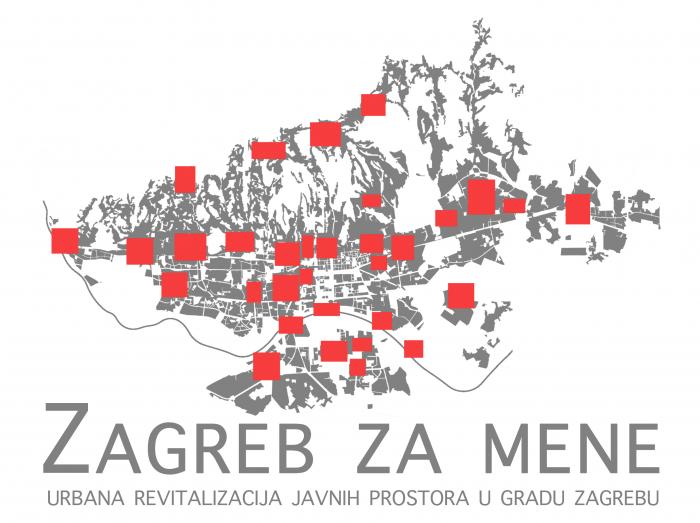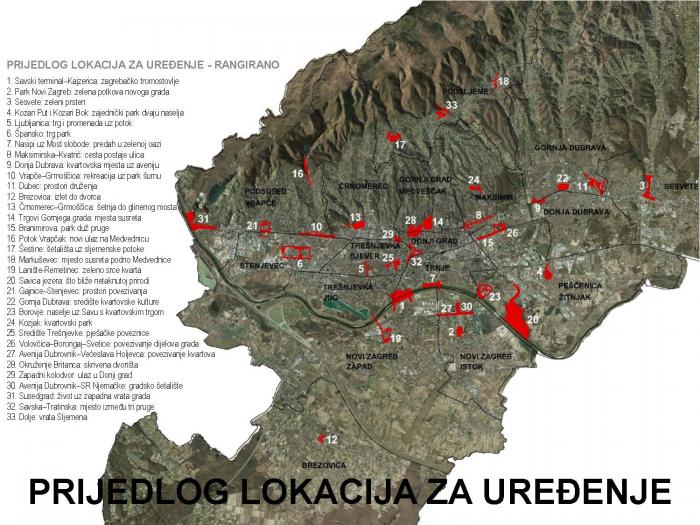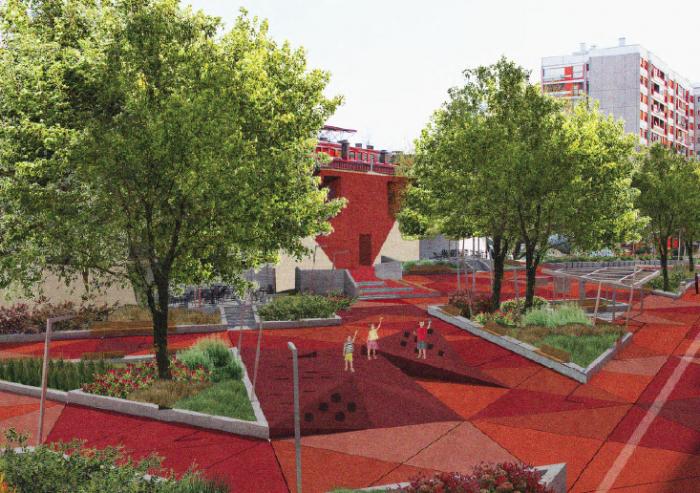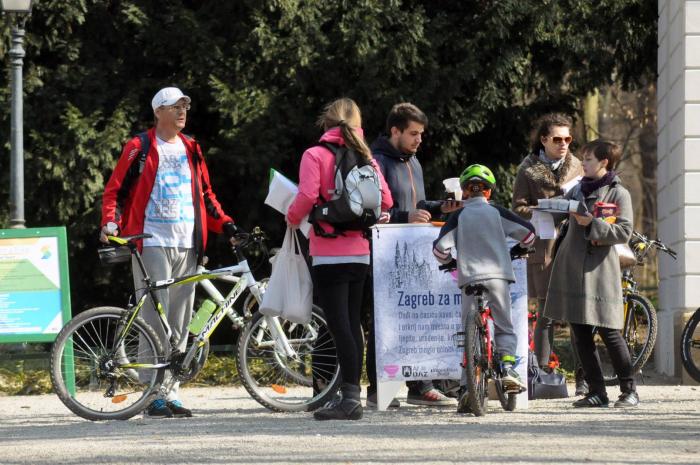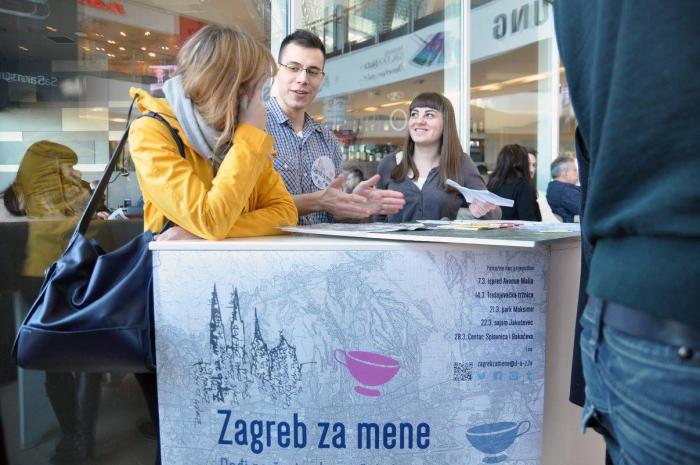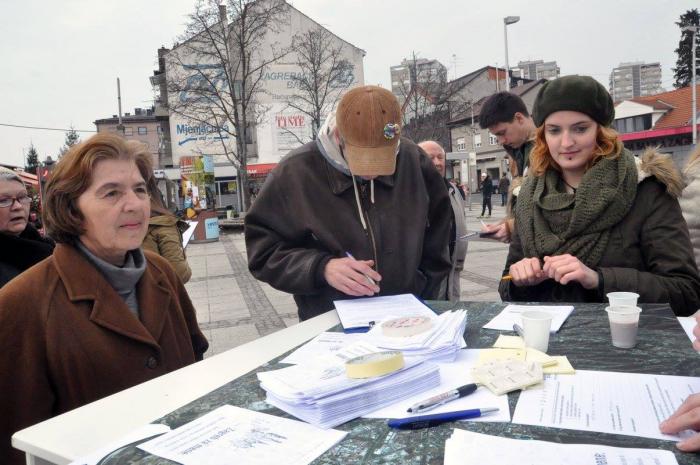I. SUMMARY INFORMATION
Project
268331
Status
Submitted
Award category
Regenerated urban and rural spaces
You want to submit
NEW EUROPEAN BAUHAUS AWARDS : existing completed examples
Project title
ZAGREB FOR ME
Full project title
ZAGREB FOR ME – PROJECT OF URBAN REVITALISATION OF PUBLIC SPACES IN THE CITY OF ZAGREB
Description
Revitalization of Zagreb's public spaces using public participation as a tool. This project aims to decentralize designed public spaces and draw attention to some forgotten city spots. At the same time, the project, created from a “bottom-up” initiative, establishes a new model of public participation as well as new forms of collaboration.
Where was your project implemented in the EU?
Croatia
Grad Zagreb
Trg bana Josipa Jelačića 3/1
Zagreb
10000
When was your project implemented?
Has your project benefited from EU programmes or funds?
No
Which programme(s) or fund(s)? Provide the name of the programme(s)/fund(s), the strand/action line as relevant and the year.
II. DESCRIPTION OF THE PROJECT
Please provide a summary of your project
In collaboration with the City of Zagreb and the Department of Urban Planning, Spatial Planning and Landscape Architecture of the Faculty of Architecture of the University of Zagreb, the Zagreb Society of Architects (DAZ) launched the project of urban revitalisation of public spaces in the City of Zagreb through the implementation of interventions in public space throughout the entire City. The interventions are small‐ to medium‐scale in scope with their investment value ranging between 10 and 20 million HRK. The expected effect of such a distributed approach is an improvement of the overall image of the City, and an improvement of the quality of urban life in the segments of housing, recreation, leisure and social cohesion. The project has been carried out since 2015.
The idea of a systematic revitalisation of public space attempts to answer this question exactly. A series of interventions in the City’s public space – interventions in the sense of designing, planning and upgrading a number of carefully selected locations with relatively small budgets, interventions which are feasible and achievable – are an integral part of this project.
The project envisages the almost simultaneous interventions in at least seventeen locations in the City. The project aims to initiate collaboration between the City, its citizens, institutions and programmes, to encourage dialogue and an exchange of ideas, to advance processes and open businesses. The project looks to revitalise already existing places, meeting places, places of the City, places where events and happenings take place in an innovative way, to revive them, to bring them back to life and to reintroduce them to the lives of citizens.
Please give information about the key objectives of your project in terms of sustainability and how these have been met
The goal of the project is to start a revitalization of public spaces through the realization of urban interventions in the whole city area at the same time. This distributed approach will improve the general “image of the city” and raise the quality of urban life in segments of housing, recreation, leisure and social cohesion. Although Zagreb has some significant historical parks and squares in its centre, as well as a few recreational zones, the rest of the city has plenty of neglected open spaces that have no specific function. The project includes development of pedestrian areas on derelict train tracks, bike paths, connecting existent green areas and adaption as areas for socialisation and recreation.
The Zagreb For Me Project seeks to detect the potentials of space which could compensate for the lack of public facilities at the local level. Spaces are often tucked away “somewhere in between”, on pedestrian or bicycle pathways, but without adequate equipment and urban features.
The programming of public space for certain activities in open areas is limited in scope. During implementation, the programme scope is determined by the overlap of different zones which are defined by individual urban parameters from the group of general status (social) determinants of public space and functional determinants which define the use of walkable surfaces and its surroundings, including traffic and movement. The perceptual‐design determinants of space are also a significant component of the image of public space.
Through small interventions which can happen in parallel with large‐scale planning ideas, the Zagreb For Me Project wishes to both develop the culture of public assembly and to encourage research of its applicative potentials with experts and professionals. At the same time – owing to the uniqueness of the programme, the unrepeatability of its appearance and content – a shifting towards these emerging hot spots in the City will be encouraged.
Please give information about the key objectives of your project in terms of aesthetics and quality of experience beyond functionality and how these have been met
Initially conducted at neighbourhood level and below, the City Acupuncture seeks to positively affect the quality of urban life through precisely designed and positioned small interventions. The three basic principles underlying this methodology are interdisciplinarity, small‐scale interventions and participation. The Zagreb For Me Project was inspired by the basic principles of the City Acupuncture and its results thus far, with the desire to apply the methodology of the City Acupuncture to the entire City as a whole. However, owing to the change which occurred in scale, i.e., from neighbourhood to city level, small interventions in the space of neighbourhoods have become small revitalisations of the City’s public space. It is with this in mind that the need to involve an urban planning study at the stage of detecting the locations and their programming, as well as the need to introduce the procedures/institutions of urban planning and architectural competition, has become a necessity. While urban planners provide an expert view of the City and its public space, the role of the City Acupuncture in the Zagreb For Me Project is to ensure the continued presence of public opinion in the project: from informing the public about the participatory methodology, through identifying the locations and the needs of the population, up to the precise programming of each location.
Using the method of the City Acupuncture research and the “bottom‐up” approach, the result of the said public opinion research was a series of information and insights which describe the needs in the public space of Zagreb, and this from the perspective of its citizens, associations and City District Councils. More specifically, having encompassed a wide range and a large number of research participants, the research analysed the 4 public space of the City across its entire territory in a quality way.
Please give information about the key objectives of your project in terms of inclusion and how these have been met
After the official project announcement, neighbourhood councils, civil society groups and experts were invited to state their opinions about the city's spatial problems and solutions. Zagreb for Me team conducted field surveys at several locations asking citizens what they think which locations they would like to have revitalized. A web platform has been established to share information about the project and to allow citizens to suggest locations online. In total 211 locations were identified, of which 51 were mentioned by numerous people. A scientific team created by the Faculty of Architecture, examined potential locations in terms of the locations importance for the city and its reference in urban planning documents. Both surveys were overlapped and 33 locations were presented and proposed for further selection by citizens.
The selection of locations and range of interventions are carried out with the active participation of the public, thus ensuring the acceptance and feasibility of this widely comprehensive project, with the aim of involving as many citizens, professional organisations and city administrative bodies as possible in this process.
The second phase of the project, the study of the locations, considers each location. Once the location is selected, and the scope of interventions and budget are defined, the general expert programme of the interventions is drafted, and urban planning and architectural competition documents are finalised for each individual location. For most of the selected locations, programmes will be developed which are planned to be tested against public opinion, thus looking to ensure citizens' participation in decision-making and the expression of real needs as a contribution to a quality programme.
This bottom-up method, viewed from the perspective of citizens and associations, resulted in a better know
Please give information on the results/impacts achieved by your project in relation to the category you apply for
The project “Zagreb for Me” was launched at the beginning of 2015 by the Zagreb Society of Architects in cooperation with the University of Zagreb’s Faculty of Architecture and Zagreb’s City Office. For now, the implementation of at least 17 interventions in public space has been announced. The project fosters collaboration between city offices, citizens and institutions, encourages discussion and the exchange of opinions, improves existing processes and creates new jobs. As well, many interesting and innovative design solutions for the upgrade of public spaces are expected to be developed which will change both identities of neighbourhoods and the whole “city image”. Interventions will range from small to medium scale and cost between 1.5 to 2.5 million Euros. Financing is meant to come from funds of the European Union and the city budget.
After the official project announcement, neighbourhood councils, civil society groups and experts were invited to state their opinions about the city’s spatial problems and solutions. ”Zagreb for Me” team-members conducted field surveys at several locations asking citizens what they think about Zagreb’s public spaces and which locations they would like to have revitalized. A web platform has been established to share information about the project and to allow citizens to suggest locations online. In total 211 locations were identified, of which 51 were mentioned by numerous people. Simultaneously, a scientific team created by the Faculty of Architecture, examined potential locations in terms of the locations importance for the city and its reference in urban planning documents. In the end, both surveys were overlapped and 33 locations were presented and proposed for further selection by citizens.
Please explain the way citizens benefiting from or affected by the project and civil society have been involved in the project and what has been the impact of this involvement on the project
With this project and its implementation, the City of Zagreb and its citizens are given modern urban spaces that we all recognise and love in all European and world capitals. The project changes the image of the City at all levels. There are manifold new value‐added benefits for both the City and its citizens: social development is achieved through participation in decision‐making, through cohesion, innovation and a professional approach. The project seeks to make people aware of the City as their home, and improve their relationship to not only public but also private space. Through this project, the City promotes itself and becomes attractive to live, study and work in, to visit and do business in. The project’s economic effects on SMEs are positive in a multiple way during both the stage of implementation and indirectly through social development concentrically and through the City polycentrically.
Please highlight the innovative character of the project
The project is based on an innovative methodology that involves close collaboration between the city and its citizens, but also professional and academic institutions, to develop ways of revitalising existing places, offer them a new life and give them back to the citizens. New added value benefits for the city and citizens are multiple: social development, achieved through participation in decision-making, cohesion, innovation and a professional approach.
Selecting the location and defining the intervention range is carried out with active public participation to ensure acceptance and comprehension of the project, aiming at involving the largest possible number of citizens, professional organisations and administrative bodies in this process.
Following the selection of locations and their budget range, preparation studies and overall professional programmes of the interventions for all individual locations are made, then carried out following the confirmation of the available budget. The design solutions for the selected locations derive from architectural contests to ensure top quality and a transparent implementation process.
The result is a series of interventions in 17 carefully selected public spaces throughout the city, providing design planning and improvement of public space with reasonable budgets.
Please explain how the project led to results or learnings which could be transferred to other interested parties
A comprehensive approach to the study, valorisation and organising of public space of the city, as it is used in the project "Zagreb For Me", represents an innovative methodology that may be of interest to other European cities. In contrast to the established practice of planning that relies fundamentally on professional planning attitudes, or those who consider space transformation on the basis of bottom-up initiatives, this method does not give preference to any of the approaches, but prefers an equal decision-making process. In this way, a fair, impartial and multi-founded solution to the problem of development of modern cities can be achieved.
Is an evaluation report or any relevant independent evaluation source available?
No
III. UPLOAD PICTURES
IV. VALIDATION
By ticking this box, you declare that all the information provided in this form is factually correct, that the proposed project has not been proposed for the Awards more than once under the same category and that it has not been subject to any type of investigation, which could lead to a financial correction because of irregularities or fraud.
Yes
